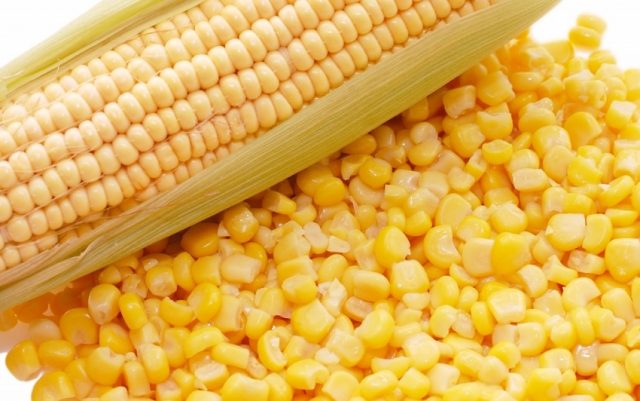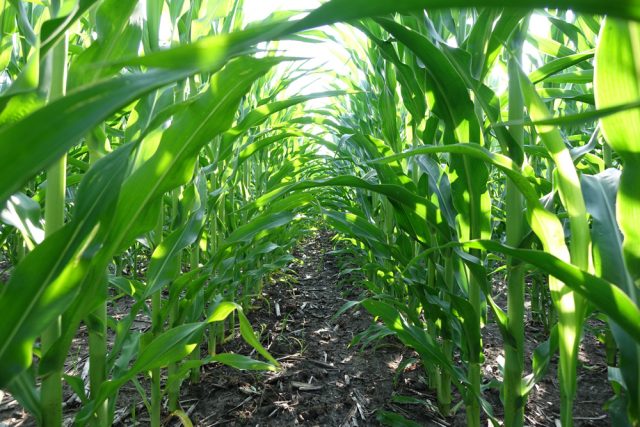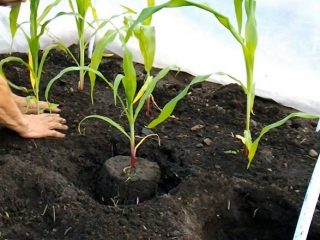Content
- 1 What is corn silage
- 2 The best predecessors for silage corn
- 3 Choosing a corn variety for silage
- 4 Timing for planting corn for silage
- 5 Preparing seeds for planting
- 6 Soil preparation
- 7 Planting density of corn for silage
- 8 Rules for sowing silage corn
- 9 How to care for corn crops
- 10 Harvest
- 11 Corn Silage Storage
- 12 Conclusion
Corn for silage makes it possible to obtain feed for farm animals. The growing process includes a number of stages: soil preparation, variety selection, seedling care. After harvesting, it is important to ensure proper storage of products.
What is corn silage
Corn is an annual plant that produces large cobs. One of the options for using the crop is to produce silage. This is the name for succulent food for animals and birds. Corn silage has a positive effect on the milk production of cows and promotes the growth of muscle mass in cattle.
Corn ensiling involves chopping the plants. Then the resulting mass is preserved without access to air. Silage has nutritional properties and a high content of vitamins. The product promotes digestion and helps other foods to be absorbed. Silage is stored in special pits or trenches.
The quality of corn silage is influenced by various factors:
- landing dates;
- sowing rate for a certain area;
- use of herbicides;
- dimensions after shredding;
- starch and fiber content.
The best predecessors for silage corn
Before planting corn, it is important to choose a suitable location for it. Pay attention to the crops that grew on the site. The best predecessors for corn are potatoes, cabbage, zucchini, beets, tomatoes, and cucumbers.
Advice! Poor precursors for corn are millet, sorghum, sugar beets and sunflowers. These plants have common diseases and significantly deplete the soil.
It is allowed to plant corn in one area for several years in a row. However, such actions lead to soil depletion. Therefore, constant irrigation and supply of minerals are provided in the fields. It is best to change the place where the crop is grown. Replanting it is possible after 2 - 3 years.
Choosing a corn variety for silage
For planting, select varieties that ripen well and contain maximum dry matter. Breeders have developed hydrides that are intended for producing silage. Planting of universal varieties is allowed. For the middle zone, early and mid-early corn are best suited. In more northern regions, only early hybrids are planted.
The best varieties for growing for silage:
- Voronezhsky 158 NE. The hybrid is used in the Central region, Volga region and Siberia. Early ripening. The plant is tall and produces ears of medium length. The yield of corn for silage is up to 73 c/ha. The variety is resistant to fungal diseases;
- Voronezhsky 230 NE. A mid-early ripening hybrid, recommended for planting in the middle zone. Ears of medium size, grains of intermediate type.Maximum yield – 87 c/ha;
- Cascade 195 NE. Early ripening corn, recommended for the Volga and Black Earth regions. The plants are tall and form ears of medium size. The harvest is harvested early;
- Baksita. The hybrid is recommended for cultivation in the North-West, in the Black Earth Region, the Volga region, and Western Siberia. Maturation occurs at an early stage. Medium height plant with short ears. The variety exhibits its properties best in the Perm region, Lipetsk and Kaliningrad regions.
Timing for planting corn for silage
Corn is planted in the spring, when the soil is well warmed up. The optimal temperature at a depth of 10 cm is +12 °C. If the variety is cold-resistant, then earlier planting is allowed when the temperature reaches +8 °C. This is usually the period from May to mid-June.
Spring cold snaps do not affect seedlings if the sprouting point is maintained. If you plant corn later, there is a high risk of reduced yield.
Preparing seeds for planting
To improve the germination of corn, its seeds are processed. This procedure is usually performed in factories. As a result, the planting material meets the requirements established by the standard.
First, the seeds are dried until the moisture value reaches 12%. Then healthy material free of stains and other defects is selected. The next stage is etching in a solution of potassium permanganate or another drug. Its purpose is to disinfect seeds, eliminate pathogens and insect larvae.
Seeds for silage are heated in the sun for 3 - 4 days. At night they are covered with a tarpaulin or put in a dry room. Immediately before planting, corn is soaked in water for 12 hours. This material sprouts faster.
Soil preparation
For corn silage, fertile soil is used that allows moisture and air to pass through well. Sandy loam, loamy soils, and peat bogs are suitable. Soil preparation begins in the fall. The area is dug up and cleared of weed. Be sure to add rotted manure.
Advice! Instead of natural fertilizers, mineral complexes containing nitrogen, phosphorus and potassium are also used.
If the soil is clayey, then in the spring it is loosened. Additionally, sawdust or straw is added. In the fields, pre-sowing cultivation is carried out using cultivators with rollers or harrows.
Planting density of corn for silage
Corn is planted in rows for silage. A distance of 70 cm is left between them. The seed consumption rate is 60 thousand per 1 ha. On average, the specified area requires from 15 to 30 kg of seeds.
The planting pattern depends on how much moisture the soil has. It is possible to reduce the distance between rows of corn. In this case, leave 50-70 cm between plants.
Rules for sowing silage corn
Corn seeds for silage are planted to a depth of 3 to 8 cm, in heavy soil - 5 cm, in sandy soil - 8 cm. The planting depth is chosen depending on climatic conditions and humidity in the top layer of soil.
Pneumatic seeders are used in the fields for planting. When the unit starts, the fan comes into operation. As a result, air is forced into the seed module and the distribution disc begins to rotate. Seeds are fed through special holes. When the seeder is in operation, furrows are also formed.
How to care for corn crops
Caring for corn for silage includes watering, fertilizing, protection from weeds, diseases and pests. At the beginning of the growing season, plantings rarely suffer from a lack of moisture.Until the period when intensive stem development begins, corn does not need watering. At this time, dry matter accumulates.
If the region receives less than 80 mm of precipitation, then additional irrigation is required. The crop does not tolerate excess moisture in the soil. As humidity increases, plant growth stops and its leaves turn purple.
The watering rate per plant is from 1 to 2 liters of water. After adding moisture, it is recommended to loosen the soil. With a lack of oxygen, the development of cobs worsens.
Fertilizers
Minerals have a positive effect on corn growth. At first, plants develop slowly. The root system is not yet powerful enough to use fertilizers applied in the fall. When growing for silage, it is important to provide the corn with nutrients. They are necessary for the formation of the stem.
To obtain high-quality silage, plantings are fed according to the following scheme:
- when the 3rd leaf is formed, slurry is added;
- for subsequent treatments, prepare a mineral solution: 20 g of ammonium nitrate, 15 g of potassium salt and 30 g of superphosphate per 10 liters of water.
Additionally, the plants are sprayed with a solution of zinc sulfate. For 400 liters of water, 300 g of fertilizer is required. This amount is enough to process 1 hectare.
Herbicides
Weeds cause decreased yields, diseases and pests. To combat them, special preparations are used - herbicides Erodikan, Aurorex, Reglon. Up to 10 liters of substance are required per 1 hectare of soil. They are embedded in the soil before planting corn for silage.
When seedlings appear, herbicides Adengo, Burbin, and Luvar are used. Consumption is 2 liters per 1 ha. There is a gap of 2 months between treatments.
Pest and disease control
Corn planted for silage can be seriously damaged by diseases and pests. The crop suffers from powdery mildew, smut, fusarium, and rust. If signs of disease appear, treatment is carried out with Optimo or Privent. Insecticides Force or Karate are used against the meadow moth, soka fly and oat fly.
Harvest
Corn is harvested for silage when the grains reach milky-waxy maturity. When you press on the cobs, a thick mass and a whitish liquid are released. Plants are mowed using special equipment. First, the cobs are removed, and then they move on to the stems. They are cut at a height of 15 cm from the soil surface.
Corn Silage Storage
Chopped corn cobs in silos are kept in special storage facilities or trenches. The mass is laid in layers 80 cm thick. Be sure to add phytoncides, which do not allow butyric acid to be released. They perform the functions of a disinfectant and ensure the fermentation process of silage.
After laying, the silo is covered with two layers of film. A weight is placed on top to squeeze out air. The minimum fermentation period is 3 weeks. The finished silage is removed in layers 30 cm thick.
Conclusion
Corn for silage is a valuable product that is used in livestock farming. It is grown on prepared soils. During the growing season, the plantings are provided with care: fertilizing, protection from pests and diseases.
















